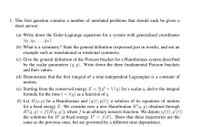
Concept explainers
Figure 1 shows the 16‐APSK constellation with 3 different arrangements of transmitted carrier states on two rings with a ratio of 2.1756 between outer and inner rings radii. You are to write a MATLAB® program (m‐file) to implement each of these M‐ary APSK transmissions (where M = 16) through an AWGN channel, including modulation (symbol generation) at the transmitter, addition of white noise in the channel, and symbol detection and determination of bit error ratio (BER) at the receiver. Your message signal will be a random sequence consisting of 403200 integers that have values between 0 and M-1 with equal probability. For each value of Eb/No in the range 4 dB to 16 dB in steps of 0.5 dB, where Eb is the average energy per bit and No is the noise power per unit bandwidth, run your simulation of the system repeatedly until at least 101-bit errors occur before calculating BER.

Step by stepSolved in 4 steps with 3 images

- A satellite at an altitude of 37654 km transmits a signal of 17 GHz to a ground station directly below it. The following data is given. • Total atmospheric losses = 40dB • Transmit antenna gain = 55dBi • Receiver antenna gain = 60dBi • Signal to noise ratio of received signal = 6dB • Receiver signal noise power = 25pW • Receiver sensitivity = -90dBW I. Calculate the power transmitted. II. Find the Fade Margin for the link and comment on your result.arrow_forward3. The radar in which both transmission and reception is done using the same antenna are called: a) Monostatic radar b) Bistatic radar c) Monopole radar d) Dipole radararrow_forward15-16. Determine the beamwidth and transmit and receive power gains of a parabolic antenna with the following parameters: dish diameter of 2.5 m, a frequency of operation of 4 GHz, and an efficiency of 55%.arrow_forward
 Introductory Circuit Analysis (13th Edition)Electrical EngineeringISBN:9780133923605Author:Robert L. BoylestadPublisher:PEARSON
Introductory Circuit Analysis (13th Edition)Electrical EngineeringISBN:9780133923605Author:Robert L. BoylestadPublisher:PEARSON Delmar's Standard Textbook Of ElectricityElectrical EngineeringISBN:9781337900348Author:Stephen L. HermanPublisher:Cengage Learning
Delmar's Standard Textbook Of ElectricityElectrical EngineeringISBN:9781337900348Author:Stephen L. HermanPublisher:Cengage Learning Programmable Logic ControllersElectrical EngineeringISBN:9780073373843Author:Frank D. PetruzellaPublisher:McGraw-Hill Education
Programmable Logic ControllersElectrical EngineeringISBN:9780073373843Author:Frank D. PetruzellaPublisher:McGraw-Hill Education Fundamentals of Electric CircuitsElectrical EngineeringISBN:9780078028229Author:Charles K Alexander, Matthew SadikuPublisher:McGraw-Hill Education
Fundamentals of Electric CircuitsElectrical EngineeringISBN:9780078028229Author:Charles K Alexander, Matthew SadikuPublisher:McGraw-Hill Education Electric Circuits. (11th Edition)Electrical EngineeringISBN:9780134746968Author:James W. Nilsson, Susan RiedelPublisher:PEARSON
Electric Circuits. (11th Edition)Electrical EngineeringISBN:9780134746968Author:James W. Nilsson, Susan RiedelPublisher:PEARSON Engineering ElectromagneticsElectrical EngineeringISBN:9780078028151Author:Hayt, William H. (william Hart), Jr, BUCK, John A.Publisher:Mcgraw-hill Education,
Engineering ElectromagneticsElectrical EngineeringISBN:9780078028151Author:Hayt, William H. (william Hart), Jr, BUCK, John A.Publisher:Mcgraw-hill Education,





